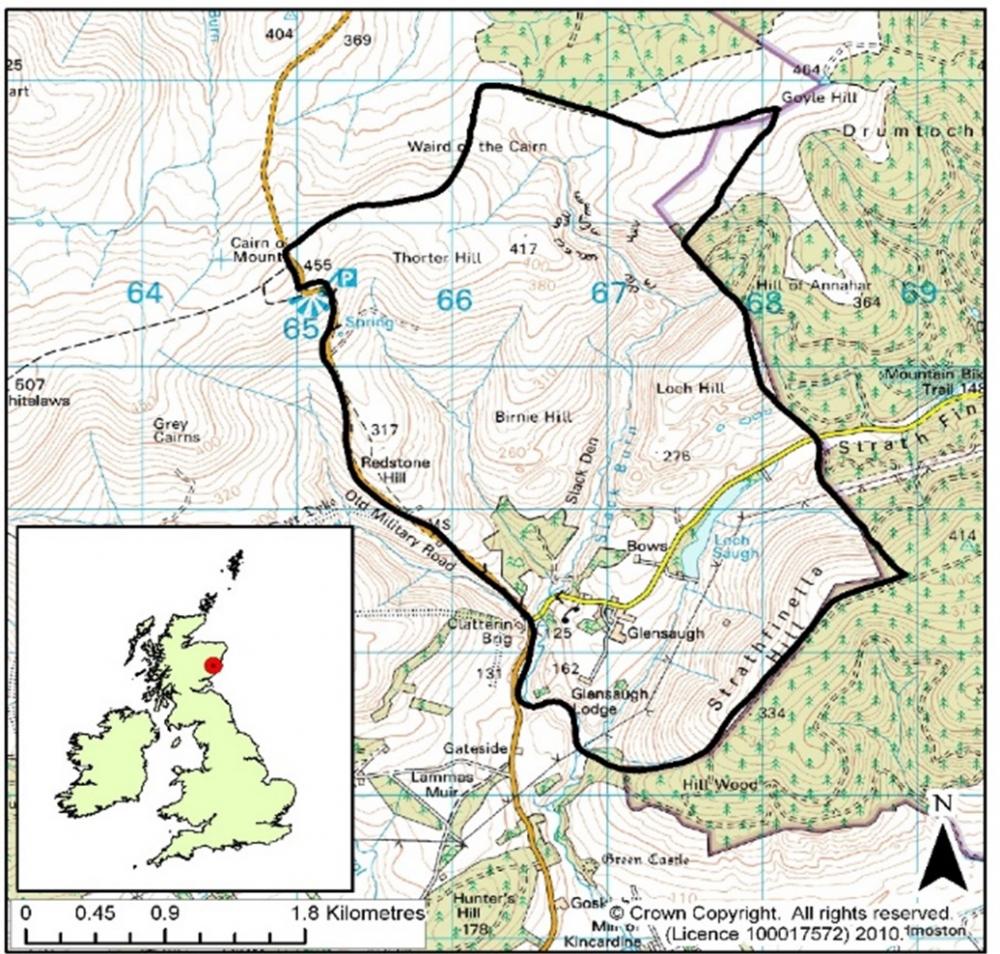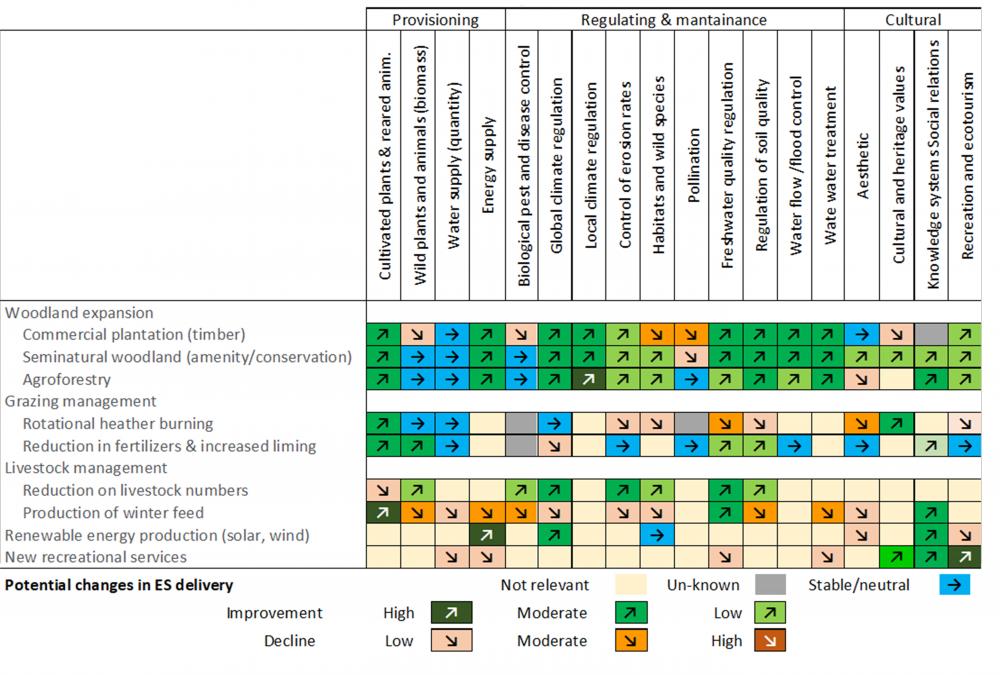Natural capital underpins sustainability and refers to the stocks of natural resources, which include geology, soil, air, water, and all living things. Natural capital accounting involves understanding, measuring, and assigning values to calculate the contribution of nature to economic activity and human well-being.
We applied the Natural Capital Protocol (The "Protocol" hereinafter) to evaluate the impacts and dependencies of traditional and diversified upland farm enterprises on natural capital, using James Hutton Institute’s Glensaugh farm as a case-study. The Protocol was developed to help business to integrate natural capital concerns into their decision-making. Glensaugh has a long legacy of research and data collection, and is a fairly typical example of a widespread upland farming system.
Our natural capital assessment included a retrospective analysis of management decisions on the farm covering the period 2002-2018, and a prospective analysis of natural capital investment involving woodland expansion, which represents one strategy to enable Glensaugh to decarbonise and move towards a climate-positive agricultural management system.
You may be also interested in another case study which synthesises insights from five pilot studies and explains how natural capital approaches can facilitate improved land management in Scotland.
Stage
Directory of Expertise
Purpose
Glensaugh, like many other upland farms, has been traditionally used for extensive livestock farming, primarily sheep in the hills, and sheep and beef-cattle in lower-ground areas (Figure 1). This farm has also diversified through investments in woodland expansion, renewable energy (wind, solar and biomass), and rural tourism. All these enterprises have a high dependency on natural capital and the resulting ecosystem services (the benefits people obtain from ecosystems). These enterprises can also have impacts on natural capital, directly or indirectly affecting the provision of ecosystem services upon which businesses and wider society depend.

Our application of the Protocol to Glensaugh’s enterprises built upon the initial Protocol application to selected Crown Estate Scotland holdings and took the assessment of the Protocol much deeper than had been possible in the Crown Estate work. Our application extended the Crown Estate Scotland approach by providing time-series assessments of the main dependencies and impacts on natural capital, and suggesting a set of physical and monetary indicators for these impacts and dependencies. The analysis covered the period 2002-2018, and is primarily focussed on livestock farming and forestry, though it also covers grassland management and renewable energy.
As a research farm, Glensaugh has been used over the years to test new farming methods for research and demonstration purposes. More recently, a climate-positive farming initiative was conceived for Glensaugh. This involves the adoption of land management techniques and carbon-neutral technologies, that once implemented can contribute to achieving and demonstrating significant moves towards climate positive farming with net-zero greenhouse gas (GHG) emissions. Our Protocol application is informing this initiative, particularly through the prospective analysis of potential natural capital impacts from proposed woodland expansion investment in Glensaugh. As such, the findings of our Protocol application are relevant to future land use policies regarding agriculture, forestry, energy and tourism in the context of the climate emergency and biodiversity crises.
Results
Glensaugh’s Natural capital: State, Dependencies and Impacts
Overall, Glensaugh’s natural capital is in relatively good condition. The mix of ecosystem services has changed, as more than 50 ha of new woodlands (mainly native trees) have been planted at Glensaugh over the last 10 years. Alongside changes in crop and livestock management strategies, the diversification activities have improved the condition of overall natural capital in terms of the capacity to deliver ecosystem services. Although the habitats simultaneously generate multiple ecosystem services, it is not possible to manage those habitats to maximize all services, and as a result, trade-offs occur (Fig. 2).

Figure 2 - Estimated changes in delivery of ecosystem services due to changes in land use and management at Glensaugh
For example, woodland expansion was found to be mainly positive for the delivery of ecosystem services, notably for improving the GHG emissions balance for Glensaugh. Nonetheless, woodland planting can impact negatively on soil carbon stocks in the immediate and short to medium term as a result of mechanical ground preparation, which needs to be carefully addressed in decision-making about methods to be used for the new woodland plantings.
GHG emissions from land-based businesses like Glensaugh are still relatively large, mainly associated with livestock farming, but also due to the use of fossil fuels (vehicles and heating), and grid electricity consumption. However, the production and use of renewable energy in recent years has created new income, reduced costs, and contributed to climate change mitigation through using wind, solar and biomass for some of the farm’s heating and electricity demands.
Changes in the management of crop, grassland, and livestock enterprises, such as reducing imported feed and maximising grazing resources, have translated into cost savings. The ratio between net profits and GHG emissions per standard livestock unit has increased for all livestock over the last 3 years, which indicates improvements in production related GHG efficiency.
Potential natural capital impacts due to woodland expansion
Woodland expansion planned for an additional 113 hectares could increase carbon dioxide sequestration by 700 to 1,500 t CO2 per year over the next 20 years, depending on the species planted, ground preparation methods, and when that planting takes place.
Woodland expansion can create further opportunities for GHG emissions off-setting. There is a trade-off between carbon sequestration and potential biodiversity gains when non-native commercial species are planted instead of native woodlands (the former being generally faster growing than the latter). There is also an economic trade-off between commercial species and native woodland, as the minimum carbon payments required to make native woodland expansion profitable can be at least double the payments required when non-native fast-growing species are involved.
Our study suggests that payments for carbon of around £12 per t CO2 for the carbon sequestration over a period of 50 years could generate enough incentive to use exclusively native woodlands in the Glensaugh woodland expansion project. This price fits in the range of carbon prices paid to forest developers in the Woodland Carbon Code, which were reported to fluctuate from £3 to £15 t CO2[1]. Woodland expansion seems also a more cost-effective alternative to improve the farm GHG balance than reducing livestock numbers, when the livestock revenues forgone are accounted for.
Benefits
The application of the Protocol to Glensaugh has demonstrated that natural capital assessment can be very useful to structure and inform decision-making pertaining to land use and management strategies. For example, the results of the assessment suggest that diversified livestock enterprises can help to better balance environmental and economic outcomes for farm financial resilience, by helping the farm enterprise respond to climatic and price fluctuations. Our assessment also showed that woodland expansion can help a farm enterprise to move towards net zero carbon emissions over the next 20 years.
The application of the Protocol was useful as framework to guide a systematic assessment of natural capital impact and dependencies. However, the application is data-demanding, and its reliability depends on the availability and quality of information. Other land-based businesses applying natural capital assessment approaches need to evaluate the implications regarding data quality and availability and potential impacts that these variables could have in informing their decision-making.
The proliferation of carbon auditing tools could assist the estimation of carbon balances at the whole farm or the land-based activity level. However, caution is needed here as this could inadvertently put the emphasis of a natural capital assessment on carbon stocks and flows, overlooking other important ecosystem services, for which quantification can be challenging (e.g. biodiversity conservation). It is critical to use a suite of natural capital indicators that are important to the farm business, even in qualitative terms, to better balance multiple environmental, economic and social goals.
This research provides evidence to help embed natural capital within land use decision-making and contributes to mainstreaming the Protocol across multiple economic sectors, particularly for small and medium sized land management enterprises.
References: [1] Snowdon, P (2015). The UK Woodland Carbon Code -I4CE. Available online here (last accessed 07.10.2020).